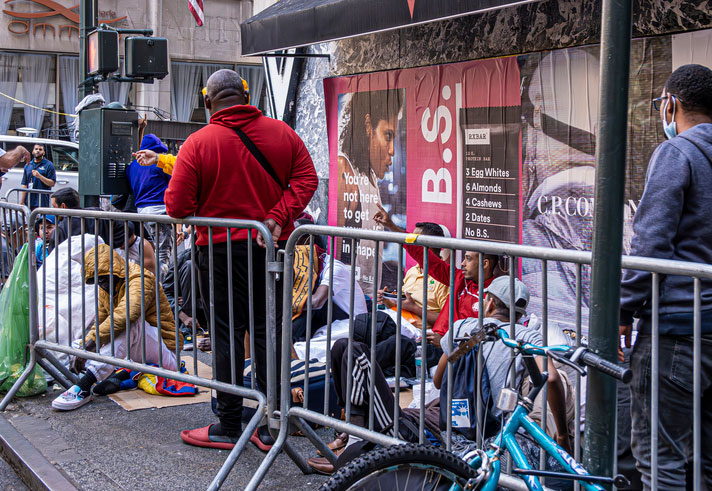Written by Scott Wilson
Immigration is one of the things that makes New York great. As the historic gateway through which waves of our ancestors from all around the world passed, the city has ushered in millions who have gone on to give America the strength and resilience to lead the world.
Recently, however, New York’s famous hospitality for the tired, poor, huddled masses yearning to breathe free has been weaponized against it.
In 2022, the governors of states like Texas, Arizona, and Florida began bussing and even flying immigrants, sometimes at considerable expense, out of their states and to the Northeast. Often using misleading practices to dupe recent arrivals, the stunt was framed as a protest of federal border policies. But it was really more of a cruel trick played on bewildered immigrants.
As it always has, however, New York’s immigration social work community has stepped up to the challenge.
Rules Driven by New York Social Workers Make the City a Haven for Refugees
New York is particularly vulnerable to becoming overwhelmed by sudden influxes of individuals experiencing homelessness regardless of their immigration status.
That goes back to a 1981 court case, Callahan vs. Carey. Coalition for the Homeless, the country’s oldest advocacy and direct service organization serving the unhoused, brought a suit against the city on behalf of Robert Callahan, who suffered from chronic alcoholism and lived on the streets. The argument in the suit was that the city had a duty to provide shelter for men like Callahan (it took further court action to expand the right for women and families).
New York City is one of only a handful of major American cities with a right to shelter mandate.
The city ultimately agreed, although tragically this came after Callahan had died on the street. But today, that agreement has become known as the Right to Shelter. It guarantees that the city will provide enough shelter beds for every homeless individual. Every case management social work specialist in the city knows the rules inside and out.
That means a $2 billion dollar shelter system and related services, public and private, that regularly puts a roof over the head of 48,000 New Yorkers with nowhere else to go. But even $2 billion isn’t enough.
Scaling up Social Services to Handle Migrants Shipped in From the South Has Been Tough

That number fluctuates naturally over time, but according to Coalition for the Homeless, it had ramped up dramatically beginning around 2011. The system expands and contracts with demand.
But doubling the number of shelter spaces in a matter of months is a whole other challenge.
That’s exactly what had to happen as new waves of migrants were brought in from the South. As of 2023, the New York Times reported that NYC alone had received over 130,000 asylum seekers. Some 60,000 of them fell under the care of the city itself, joining those 48,000 New Yorkers already in homeless shelters before the wave.
While the city is both legally obligated and naturally inclined to accommodate and offer caring assistance to migrants, it’s been a shock to the support system as numbers doubled in only about a year. More than 200 emergency shelters were opened in 2023 while services ranging from emergency housing grants to child care funding were dramatically expanded.
It wasn’t an entirely smooth process, however. Under Mayor Eric Adams, the city pushed back against the Right to Shelter requirement, arguing that the ongoing nature and costs weren’t what the system was designed for. A settlement between the city and the Legal Aid Society was put in place to apply some limits on stays for certain adults for the duration of the migrant influx.
New York Social Workers Innovate to Maintain a Shelter System on the Edge
But there are serious barriers to new immigrants trying to get out of shelters. Without built-in family supports, without language skills, without any understanding of the culture and human services systems in the United States, they face a steep climb to find work, find healthcare, find housing on their own.
Some people hurl the term sanctuary city around like it’s an epithet. But New York social workers have always thought it was more of a compliment.
This is where New York’s social workers have stepped up. And it’s showing up with new efforts like Her Migrant Hub.
Her Migrant Hub is a social work initiative kicked off by activists who had gone through forced migration experiences and fueled by social work graduate students from Fordham University, one of the premier schools of social work in Manhattan.
The site seeks to amplify the voices of asylum seekers and offer anonymized access to resources for:
- Mental Health
- General and Reproductive Health
- Childcare
- Housing
- Employment
- Substance Abuse Treatment
As immigrants and women, the people behind the organization understand at a deep level the disconnection and difficulty of navigating the path to these resources for new arrivals. Intersectionality is the watchword for social workers who, despite intensive training through master’s degree programs in social work, may still need to hear the personal stories of migrant women to grasp the reality of their lives.
It’s not just immigration-focused social workers who are stepping up to the challenge, either. Established New York City aid organizations like The Door, which empowers young people of all races, creeds, and immigration statuses, also swung into action, offering direct legal services for younger immigrants and working to protect the rights of unaccompanied minors detained in Office of Refugee Resettlement facilities.
Shepherding Refugees and Immigrants to Permanent Status Requires Advocacy on Top of Direct Services

Responses like Her Migrant Hub and The Door are amazing, but in some ways represent only the tip of the iceberg. Dealing with immediate issues is critical, but it’s not the same as helping new immigrants build a full life in their new country.
Much of the drag in that process comes from the same people who initiated the busing efforts in the first place. An immigration process has been put together that is intentionally hostile and overwhelmingly bureaucratic, miring refugees in limbo for years rather than supporting them in getting on with safe and productive lives.
Social workers have an answer for that, too, although it’s slower and less certain. Yet again, though, New York social workers are out in front on the issue.
That comes through powerful advocacy organizations like the New York Immigration Coalition. Their immigrant rights efforts come at the local, state, and federal levels. Throughout the crisis, they’ve been lobbying to expand state funding for immigration legal representation for those facing deportation. They’re also fighting to keep federal Immigration and Customs Enforcement out of New York City detention processes, ensuring greater trust for local policing—and less potential for abuses within the immigrant community.
These kinds of organizations aren’t just popping up overnight. In many cases, the framework for dealing with the influx of immigrants in 2023 was already laid out in response to the Trump Administration Muslim ban in 2017. Groups like the Immigrant Defense Project, HIAS, and even the state and local chapters of the National Association of Social Workers had already developed expertise in immigration and shelter law. They also had experience protecting the rights of new arrivals, which played a role in ensuring support for the current wave of refugees.
As of mid-2024, the last bus rolled out of Texas, heading north toward New York with only 50 migrants on board.
But in an unstable world with an uncertain situation at the southern border, anything can happen. When it does, New York’s social workers will be ready once again to make sure those in need are taken care of whenever they arrive – no matter where they are from.

